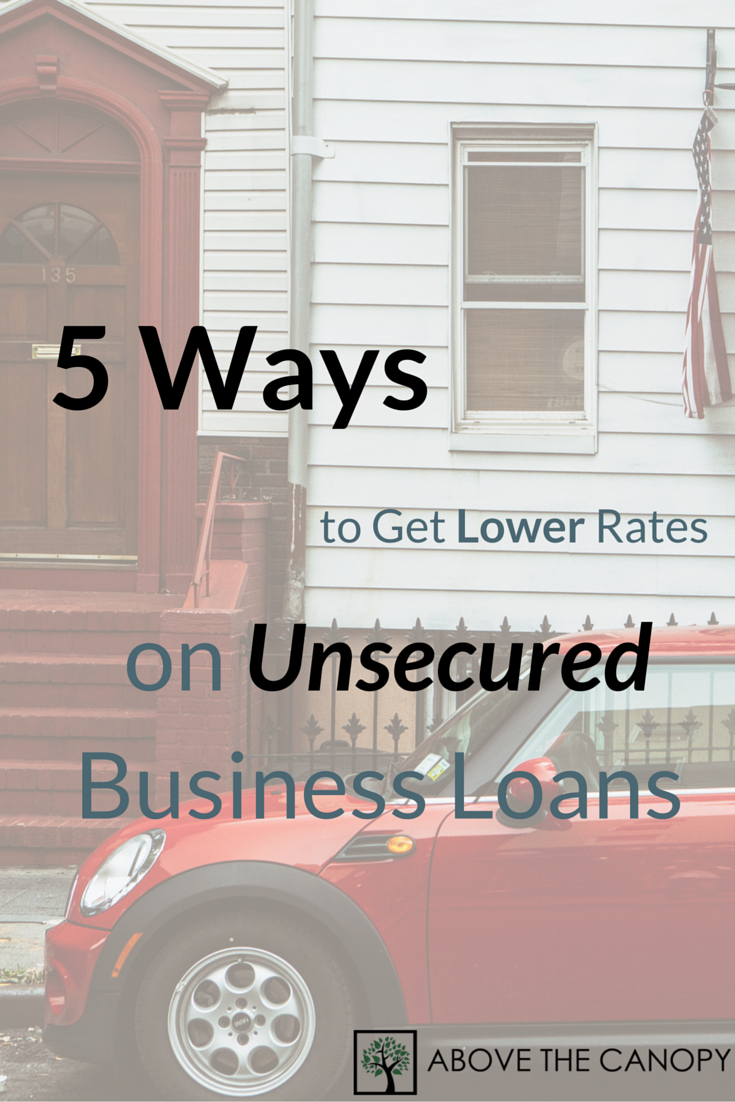Borrowing money is a way of life for most entrepreneurs and business owners. I recently read that 80% of businesses rely credit to finance their ongoing operations.
Entrepreneurs often don’t have many options when it comes to procuring credit. And any time you don’t have collateral to put up against a loan, you’re venturing into the unsecured business loan market.
Many small business experts advise against taking out an unsecured business loan. The rates are high and the terms can be kryptonite to your bottom line.
But for many of us, unsecured business loans are our only option. If you ever find yourself in this situation, this post will cover 5 ways to improve your rate on unsecured business loans.
But before we dive in, let’s review the ins and outs of a unsecured business loans.
Unsecured Business Loans
Loans are considered “secured” any time you put up collateral in order to borrow money. Banks love collateral, since they have an asset they can take over and sell if you’re not able to repay your loan.
Car loans and mortgages are two examples of the most common secured loans.
As you can guess, loans that aren’t backed by collateral are considered unsecured. Rather than relying on collateral, lenders trust a borrower’s full faith and credit.
Student loans and credit cards are two prime examples here.
Qualifying For an Unsecured Business Loan
Since banks take on more risk when lending on an unsecured basis, they’ll want to know a lot about you before lending you any money. Your borrowing & repayment history, personal finances, and business cash flow are all under scrutiny when you apply for an unsecured loan.
To make the process easier it helps to prepare the following information in a neat, organized way:
- Business finances: balance sheet, income statement, and cash flow records
- Personal finances: all your assets and liabilities, bank statements, and tax returns
- A polished business plan
- An accurate credit report
There are great borrowing resources available online these days, meaning that you no longer need to step foot in a bank to get a loan.
If you do plan on walking into a bank (especially smaller community banks), looking sharp and organized can still help your chances. Make sure you clean up, dress nicely, and have a polished presentation of your business plan ready to go.
Loan officers in community banks can have a great deal of discretion over underwriting, whereas larger national banks have institutionalized procedures and underwriting standards. If you plan on applying with a community bank, you can improve your chances by being organized and giving a killer presentation.
Most Important Underwriting Criteria
Regardless of how good your presentation and sales skills are, a lender’s willingness to loan you money mostly comes down to raw numbers.
This is true in any loan, and moreso when it comes to unsecured credit that’s not backed by collateral. In secured loans lenders are more willing to let you slide. If things go south, they can always seize your collateral.
When issuing an unsecured loan, lenders will be extra cautious throughout the underwriting process. They want to make absolutely sure that you’re a responsible borrower and will repay the loan, since they have little recourse if you don’t.
Capacity
Lenders will never hand out more money than you can repay. If you’re borrowing money for a business that’s netted $50,000 per year for the last three years, you probably won’t get a loan for $5,000,000.
To gauge your capacity to repay a loan, banks and other lenders will look at how much outstanding debt you currently have. They’ll also look at your monthly income compared to your principal and interest payments, also known as your debt to income ratio.
Credit History
No surprise here. Having a clean credit report and good credit score is one of the biggest factors in the underwriting process. This is a lender’s only insight into your borrowing and repayment history. Showing a track record of responsibility can give lenders a lot of confidence that they’ll get their money back.
It’s wise to review your credit report once per year. The three ratings agencies do make mistakes sometimes. Before filling out a loan application it’s best to make sure that your report doesn’t have any surprises on it.
The ratings agencies are required to let you view your report once per year. There are also a lot of companies that offer “free” credit reports, but only if you sign up for their credit monitoring services. Don’t use any of these services.
You can access your truly free credit reports at AnnualCreditReport.com. This is the source approved & recommended by the FTC.
Conditions
Some loans come with very specific conditions, which are sometimes called “covenants”. These conditions might be related to how much debt the borrower is allowed to take on, or related to specific payment terms.
For example, a lender might issue an unsecured loan on the condition that the borrower refrains from taking out any additional debt.
The same lender might include a prepayment penalty condition on the loan. If the borrower pays back the lender before the loan is due, they’d incur a penalty. Prepayment penalties are not uncommon, and are meant to protect the lender’s interest income on the loan.
The more conditions that favor the lender, the lower the rate on the loan.
5 Ways to Get Lower Rates On Unsecured Business Loans
Be Flexible on Loan Terms
APR is one of many terms in unsecured business loans. If you can be flexible on other terms, lenders might be able to offer you a lower rate. Here are some ideas:
- Agree not to borrow additional funds
- Agree to a prepayment penalty
- Extend the repayment period of the loan. Lenders often offer lower rates on longer unsecured business loans. This allows them to earn more interest income over time.
Brush Up Your Business Plan
At the end of the day, a lender is going to have to decide how likely it is that they’ll get their money back.
Articulating exactly what you’ll use the money for & how it will boost your profits goes a long way. Back up your logic and conclusions with facts and hard data, and practice your delivery. Communicating your plan effectively and powerfully will go a long way.
Talk to Several Lenders
There’s more than one place to get an unsecured business loan. Talk to several lenders and attempt to negotiate with each one. You may not get far if you don’t have any leverage, but it can’t hurt to try.
Make sure to consider peer to peer lenders in your search. This is a fast growing market, and you’ll often find the best terms by bypassing the traditional brick and mortar banks. Lending Club, Kabbage, and OnDeck Capital are three of the leaders for unsecured business loans. NerdWallet did a solid comparison of the various options, which you can find here.
Consider a Cosigner
This may not sound appealing, but adding a cosigner will make lenders far more willing to lend you money. Cosigners give them more security, and another avenue to recoup losses if you’re unable to pay back the debt.
Business partners make the best cosigners. Since you both have “skin in the game” you can share the pressure of repaying the loan with profits from your business.
Clean Up Your Credit
Checking your credit report and correcting mistakes is a good start. Also keep in mind that there are opportunities to manage your credit score. Taking advantage of them will improve the terms you can command on an unsecured loan.
To start, your credit report only goes back for 7-10 years. Unpaid collections will lapse after 7 years along with bankruptcy under chapters 7 and 11. Chapter 13 bankruptcy and accounts paid as agreed remain on your report for 10 years. Equifax has a good rundown here.
If you’re under a time constraint you may not have the flexibility to wait until your score improves. If you can afford to, it will help to hold off until any late or unpaid debts fall off the report entirely.


